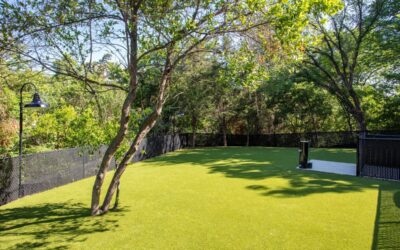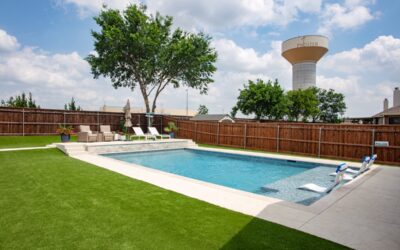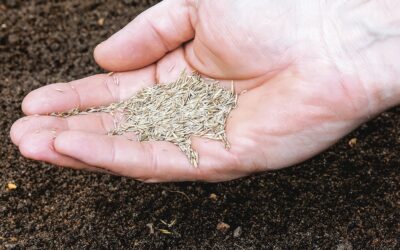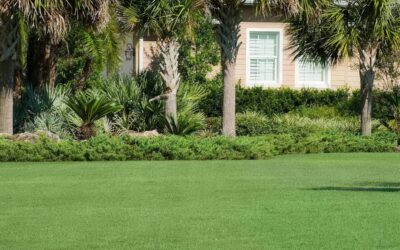Uneven, creased or lumpy artificial turf not only looks terrible. It could create trip hazards for your family using an artificial grass lawn, playground or swimming pool area.
Most times, these imperfections are due to poor installation quality—especially from homeowners who install the turf themselves or inexperienced installation teams.
Installing artificial grass requires a lot more than simply purchasing a roll from a DIY store and rolling it out like a carpet on the floor. Proper ground preparation for artificial grass is essential. Without that, lumps or creases could develop and there may be no simple way to flatten these out.
So, let’s look at how to fix lumpy artificial grass…
Why does artificial grass get lumpy or wrinkled?

Bumps, creases, wrinkles or kinks were not what you expected when you pictured an artificial grass lawn in your backyard.
So, why do these imperfections develop on surfaces that should be perfectly smooth and look immaculate all year for years on end?
Artificial grass installation is more technical than some homeowners realize. Professionals generally take a whole day to prepare the ground and lay the turf, using specialist equipment.
If corners are cut, problems can arise. These are usually due to one of several reasons…
Turf installed on an uneven surface
When artificial turf is installed on an uneven surface, lumps can appear. To some extent, synthetic turf is highly flexible, taking the shape of the ground below it. If that ground is uneven, the appearance of the grass laid on it will suffer.
This is obvious even to most inexperienced DIYers but when the ground beneath the artificial turf has not been prepared properly, uneven areas are not always evident. Artificial turf, like a carpet, is quite unforgiving and will show any imperfection beneath the surface.
Rocks, twigs, tree roots, and so on can create challenges with creating an even surface below the grass. Objects must be removed and holes filled in.

How to prevent this problem
If you are in any doubt about how to lay artificial grass, call the professionals. The team at DFW Turf Solutions installs synthetic grass areas every day and is well used to working with nature to overcome challenges and provide the ideal environment for the turf in its new home.
Turf installed without a base layer
Once the soil has been flattened, an appropriate base layer should be installed and compacted over it for the artificial grass to be laid on. If this step is missed, lumps, creases, and kinks may develop.
How to prevent this problem
Again, professional installation will ensure that a high-quality base layer of finely ground rock, decomposed granite, and gravel (“shale”) will be prepared.

This greatly reduces the chances of creases forming.
Turf installed without being properly stretched and secured
During installation, artificial turf must be lightly stretched and firmly secured to flatten any creases or wrinkles. This is often attempted as a DIY job but, if not done correctly, can result in imperfections developing as the turf area settles.

How to prevent this problem
During a professional installation, our team will let the grass sit in the sun for an hour or two before attempting to install it. We’ll then flip the material over, lightly stretch it, and then let it settle for a few minutes before installing.
We’ll push out all the wrinkles while nailing behind the piece of turf at the same time to secure it. This prevents wrinkles from forming later.
Turf installed without the correct infill placement
With a professional installation, the correct type and amount of infill are placed on the artificial grass area as the final step after all of the ground preparation, stretching, and securing of the turf.
The infill adds weight to the installation, keeps the turf fibers upright, and prevents wrinkling. If corners are cut and an insufficient amount of infill Is added. It can encourage wrinkles and kinks to form in the turf area.

How to prevent this problem
Our installation team uses high-quality silica-based infill, usually placing the infill when the temperatures are cooler and the risk of wrinkles developing from the midday or early afternoon heat is reduced (see next point).
Expansion in high temperatures
High temperatures alone won’t melt artificial grass but can lead to some other issues in poor-quality and/or poorly installed turf.
Sometimes, excessively high temperatures can cause the turf’s backing material to expand and lead to wrinkles developing but these are normally temporary and disappear after the weather cools down a little.

How to prevent this problem
This problem can be prevented by choosing high-quality artificial turf installed by professionals. Our team recommends turf that uses special cooling technology to reduce its surface temperature.
The grass should be rolled out and warmed in the sun for an hour or so before installation begins.
New grass installations that haven’t “settled” yet
Some new grass installations may appear to have lumps, kinks or lines simply because the turf has been tightly packed after manufacture, sale, and delivery. It will take time for the turf to regain its standard shape when unpacked.
So, these types of imperfections are usually temporary problems that disappear as the new turf settles within the first day of installation.

How to prevent this problem
Our turf installation professionals usually unpack the material well before it’s installed so that it has time to “breathe” and regain its proper shape before installation, without any wrinkles.
After installation, cross-brushing with a stiff brush or garden broom will encourage the artificial grass blades to stand up.
Common problems associated with uneven turf
Lumpy, wrinkled, grooved or creased artificial turf can lead to several issues beyond the obvious unsightliness of the area.
These include:
- Tripping hazards for families, who may use the lawn for play, sports, picnics, etc.
- Pooling water leads to a host of problems, including mold and algae growth, weeds, etc.
- Reduced usability negates one of the main benefits of artificial grass, which is its usability all year round.
- Lower curb appeal due to the poor aesthetics of a lumpy artificial lawn in front of the house.

How to fix lumpy artificial grass
You’ve seen how to prevent wrinkles in artificial grass during installation but how do you flatten out creases and lumps in artificial grass that are already there?
Or should you simply rip it up and start again?
A turf professional may be able to fix up the area, depending on what’s causing the wrinkles. Sometimes, as we have seen, the imperfections are temporary and will dissipate after the turf area settles.
Other times, creases or wrinkles can be brushed out to improve the appearance of the turf area.
If the creases happen because of the infill, a professional will advise you on adding and distributing the right type and quantity of infill to solve the issue.
If the problem stems from the turf not being stretched and secured properly, our professionals may be able to re-lay the turf properly.
Otherwise, if the lumps linger, the turf is poor quality, and the ground underneath the turf is causing the problems, a repair job can become long and expensive. Heat and weight rollers may help to flatten the turf but, alternatively, it may be advisable to start again, depending on the available budget.

Don’t attempt to fix these problems without professional help or your turf area could end up getting even messier.
Just to reiterate, prevention is better than cure with artificial grass issues. An inexperienced turf installer is the single biggest reason for wrinkles appearing in the turf.
If it’s too late and the wrinkles are already there, call one of our artificial grass professionals for a full assessment of the problem area.
Other problems to be wary of with artificial grass
Most artificial grass problems can be avoided with high-quality grass and a professional installation.
A trouble-free life is why many homeowners opt for artificial turf in the first place but low maintenance is not much good if your lawn develops wrinkles and looks awful because of it. It pays, therefore, to hire a dependable installation company.
Problems usually develop if inferior-quality grass is selected and corners are cut during installation. Typically, in addition to a lumpy or wrinkled appearance, these problems include:
- Loose or lifted edges: usually from areas of turf not being secured properly, potentially causing trip hazards.
- Drainage problems: often from poor ground preparation on clay-based soils or an overly compacted base layer, leading to pooling water or unpleasant odors from pet pee not draining away from the turf effectively.
- Sinking and slumping: if it looks like your turf has slumped or dips start to form on the surface, it may be due to a poorly compacted sub-base layer.
- Weeds: weeds are not usually a problem for most well-installed and well-maintained artificial grass areas but can start poking through the drainage holes or from the edges of the turf. They can also grow from the infill.
- Moss and algae buildup: moss and algae are rarely problems for artificial grass but organic matter or debris trapped in poorly maintained turf can attract unwanted growth in moist conditions.
- Visible seams: if you pay good money to meet the significant upfront costs of artificial grass, you should expect your turf area to look seamless and immaculate. Visible seams and lines are the result of a poor installation.
- Melting turf: reflections from energy-efficient windows or other shiny surfaces in the yard are the main reasons for melting artificial turf rather than hot sunshine alone.

Fix and prevent lumpy or creased artificial turf
Most homeowners install artificial grass for a hassle-free, low-maintenance lawn that looks great year-round and saves money over real grass. To many, it’s considered an investment for the future.
Bumps, kinks or creases are not part of the deal but can arise if you make poor decisions during the installation process. Get high-quality grass installed professionally and potential problems that lead to these unsightly issues can be prevented.
Like most issues with artificial grass, prevention is much easier, cheaper, and better than a cure.
If you have lumpy artificial turf, get professional assistance to fix it. Talk to an artificial grass professional at DFW Turf Solutions to discuss your turf options.






